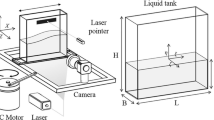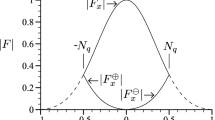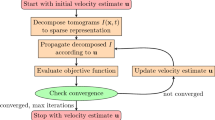Abstract
Velocity gradient is typically estimated in Particle Image Velocimetry (PIV) by differentiating a measured velocity field, which amplifies noise in the measured velocities. If gradients near a boundary are sought, such noise is usually greater than in bulk fluid, because of small tracer displacement, uncertainty in the effective positions of velocity vectors, intense deformation of tracer patterns, and laser reflection. We consider here a modified form of the Particle Image Distortion (PID) method todirectly calculate velocity gradients at a fixed wall, and refer it as “PIV/IG” (“Interface Gradiometry”). Results from synthetic 2D PIV images suggest our method achieves higher SNR and accuracy than velocity differentiation. Also, we have developed a procedure to reconstruct three-dimensional velocity gradient at a fixed wall the two non-zero components from PIV/IG data obtained in stereo views; these equations simplify considerably thanks to the no-slip condition. Experimental data from the bottom wall of turbulent open channel flow appear to suffer from a form of pixel locking. As with standard PIV, this underlines the importance of adequate tracer diameter in the images, sufficient seeding density, and of dynamic range of the camera sensor.
Similar content being viewed by others
References
Fincham, A. and Delerce, G., Advanced optimization of correlation imaging Velocimetry algorithms, Exp. Fluids 29 (2000), 13–22.
Gui, L., Wereley S. T. and Kim H. Y., Advances and applications of the digital mask technique in particle image velocimetry experiments, Meas. Sci. Technol., 14 (2003), 1820–1828.
Hart, D., PIV processing using multidimensional correlation, 10th International Symposium on Flow Visualization (Kyoto, Japan), (2002).
Huang, H. T., Fiedler, H. E. and Wang, J. J., Limitation and Improvement of PIV, Part II: Particle Image Distortion, A Novel Technique, Exp. Fluids, 15 (1993), 263–273.
Lin, H. J. and Perlin, M., Improved methods for thin, surface boundary layer investigations, Exp. Fluids, 25 (1998), 431–444.
Mayer, S., A generalized processing technique in digital particle image velocimetry with direct estimation of velocity gradients, Exp. Fluids, 33 (2002) 443–457.
Md. Shafiquzzaman, Wells, J. C., Nanao, M., Kubo, M. and Nakajima, J., Attachment of Xanthomonas Maltophilus to Bioreactor Support Particles: Influence of Shear Stress and History Effects, Proceedings of the 38th Annual Convention of Japan Society on Water Environment (Hokkaido, Japan), (2004–3), 448.
Nguyen, C. V. and Wells, J. C., Investigation of near-wall coherent structures by stereo particle image velocimetry, Proceedings of FEDSM’03, 4th ASME-JSME Joint Fluids Engineering Conference (Hawaii, U.S.A.), (2003–7(a)).
Nguyen, C. V. and Wells, J. C., Measurement of wall velocity gradient in Stereo Particle Image Velocimetry, 54th Annual meeting of the A.P.S. Division of Fluid Dynamics (Rutherford, N.J., U.S.A.), (2003–11(b)).
Nguyen, C. V., Phan, N. M. T. and Wells, J. C., Deforming P.I.V. templates to measure interfacial velocity gradients, with extension to a stereo arrangement, Int. Conf. on Advanced Optical Diagnostics in Fluids, Solids and Combustion (Tokyo, Japan), (2004–12), V0045.
Okamoto, K., Nishio, S., Saga, T. and Kobayashi, T., Standard images for particle-image velocimetry, Meas. Sci. Technol., 11 (2000), 685–691.
Phan, N. M. T., Nguyen, C. V. and Wells, J. C., Direct Measurement of Surface-Normal Velocity Gradient at a Free Surface by Deforming PIV Templates, Proceedings, 6th World Conference on Experimental Heat Transfer, Fluid Mechanics, and Thermodynamics (Matsushima, Japan), (2005).
Ruan, X., Song, X. and Yamamoto, F., Direct measurement of vorticity field in digital particle images, Exp. Fluids, 30 (2001), 696–704.
Scarano, F., Iterative image deformation in PIV, Meas. Sci. and Technol., 13 (2002), R1-R19.
Tokumaru, P. T. and Dimotakis, P. E., Image correlation Velocimetry, Exp. Fluids 19, (1995), 1–15.
Wells, J. C, Sugimoto H, Nguyen, C. V. and Kishida, K., Camera calibration for stereo P.I.V. with a front-rear camera arrangement, application to open-channel flow, Annual Journal of Hydraulic Engineering, JSCE, 47 (2003).
Willert, C., Stereoscopic digital particle image velocimetry for application in wind tunnel flows, Meas. Sci. Technol., 8 (1997), 1465–1479.
Young, C. N., Johnson, D. A. and Weckman, E. J., A method to anchor displacement vectors to reduce uncertainty and improve particle image velocimetry results, Meas. Sci. Technol., 15 (2003), 9–20.
Author information
Authors and Affiliations
Additional information
Chuong V. Nguyen: He received his B.Sc. in Aeronautical Engineering in 2001 from Ho Chi Minh City University of Technology, Vietnam. In 2003, he received his M.Sc. in Civil and Environmental Engineering from Ritsumeikan University, Japan. Currently he is a Ph.D candidate in the Department of Mechanical Engineering, Monash University, Australia. His research interests are PIV and Holographic PIV for wall-bounded flows.
John C. Wells: He obtained a Doctorate in Mechanics from the University of Grenoble I, France, and has worked at Ritsumeikan University as an Associate Professor in the Department of Civil and Environmental Engineering since 1999. His research interests are wall turbulence and sediment transport micromechanics.
Rights and permissions
About this article
Cite this article
Nguyen, C.V., Wells, J.C. Direct measurement of fluid velocity gradients at a wall by PIV image processing with stereo reconstruction. J Vis 9, 199–208 (2006). https://doi.org/10.1007/BF03181763
Received:
Revised:
Issue Date:
DOI: https://doi.org/10.1007/BF03181763




